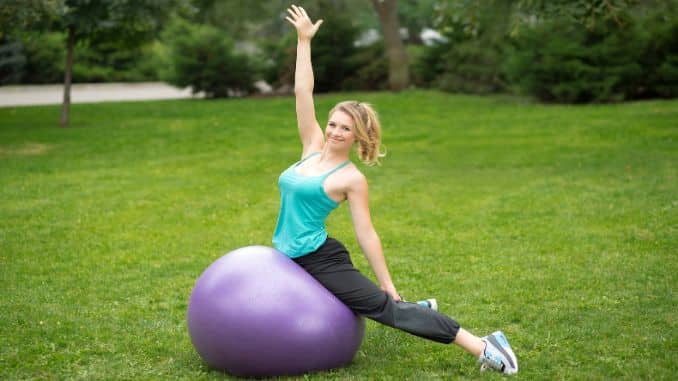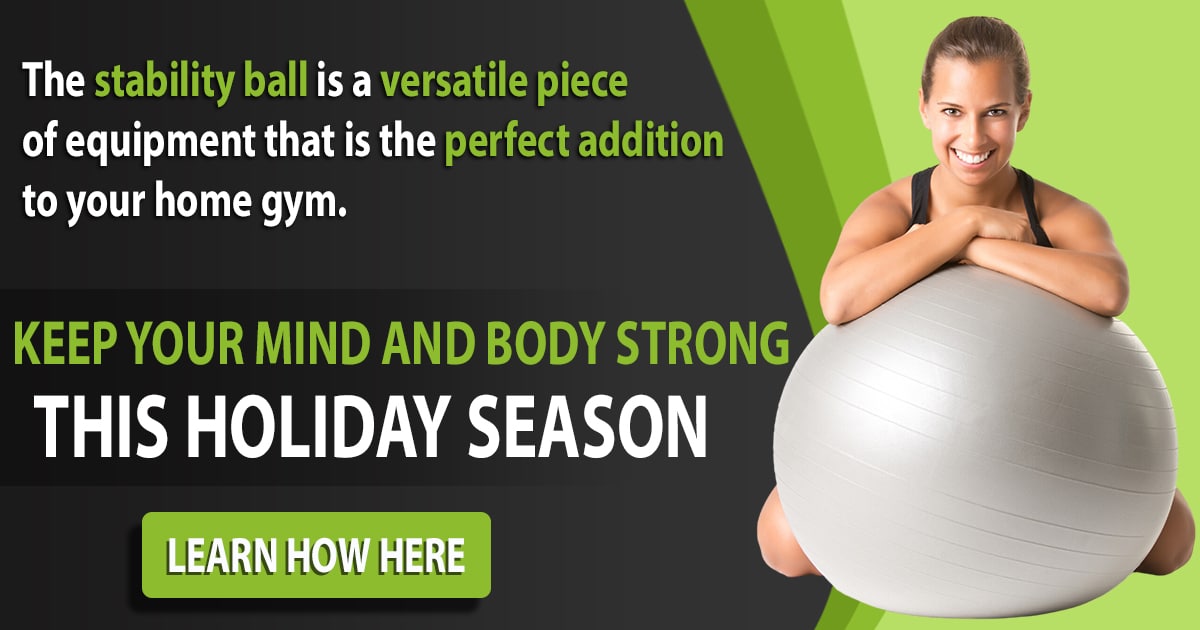Using a stability ball, also known as an exercise or workout ball, can be a great way to move your body and improve your overall fitness. Stability ball exercises are designed or can benefit challenging your body in new ways, using the ball to engage different muscles and improve your balance and core strength. Exercising with a workout ball in your routine can work your body forms and improve your posture, flexibility, and coordination.
Move your Body
In today’s world of constant sitting and being glued to screens, it’s important to take a break and move your body whenever possible. A great way to do this is with the stability ball, a fun and effective alternative to a traditional office chair. Not only does it give you an excuse to get up and move, but it also engages your core and strengthens your body.
Sitting on a stability ball for a few minutes daily can help you stay focused and energized throughout your workday. It’s also a great way to take a mini break from your computer and give your eyes a rest. So if you’re feeling stuck in your seat, switch to the stability ball and move your body for a few minutes. Not only will you feel better, but you’ll also be doing your body some good!
The Stability Ball Trend
Stability ball workouts began in the 1960s as part of a physical therapy program designed to help people with neurological conditions, such as cerebral palsy, improve their balance and coordination. The balance balls were originally called the “Swiss Balls” as it was created by an Italian plastics manufacturer called Aquilino Cosani and was later imported to Switzerland.
In the 1980s, fitness professionals began incorporating the stability ball into their workouts to improve core strength and stability. Personal trainers and physical therapists realized that the ball could be used as exercise equipment to help engage the core muscles, improve balance, and increase flexibility.
Types of Stability Balls
Here are several types of stability balls designed to suit a specific purpose.
1. The Exercise Ball, or Swiss Ball.
It is larger than a traditional stability ball and is designed for intense workouts. It’s great for core and abdominal exercises, as well as for increasing flexibility and balance.
2. The Yoga Ball
It is slightly smaller and firmer, ideal for stretching, yoga, and Pilates.
3. The Peanut Ball
It is a unique type of stability ball shaped like a peanut and is great for targeting smaller muscles.
4. Therapy Ball
It is used for physical therapy and rehabilitation and is designed to support the body during exercise.
No matter which type you choose, Stability Balls can be a great addition to any workout routine.
Benefits of using exercise balls during a mini break
- Improve Posture
- Increase Circulation
- Relieves Tension in the back, neck, and shoulders.
- Helps maintain focus and concentration.
Ideas for using exercise balls during a mini break
- Sitting on a ball instead of a chair
- Performing stretching exercises on the ball
- Doing core strengthening exercises on the ball
- Using the ball for a quick cardio workout
How to incorporate exercise balls into a mini break
- Set a timer for 10-15 minutes.
- Choose 2-3 exercises to perform during the break.
- Perform each exercise for 1-2 minutes, then take a 30-second rest.
Precautions and Safety Tips
- Choose a properly sized stability ball.
- Use caution when performing exercises on the ball, especially if you are new to using it.
- Stop immediately if you feel pain or discomfort.
Best Stability Ball Exercises
1. Overhead Squat
For this exercise, you will need a large-size stability ball.
Begin in an upright standing position with your feet considerably wider than your shoulder width apart, maintaining good alignment with your head, shoulders, and hips Hold a stability ball with both hands overhead. Engage your core and bend your knees down into a low squat position. Keep your knees behind your toes. Raise back up to the starting position, squeezing your glutes at the top position. Repeat the movements. Complete 1 Set of 8-10 repetitions.
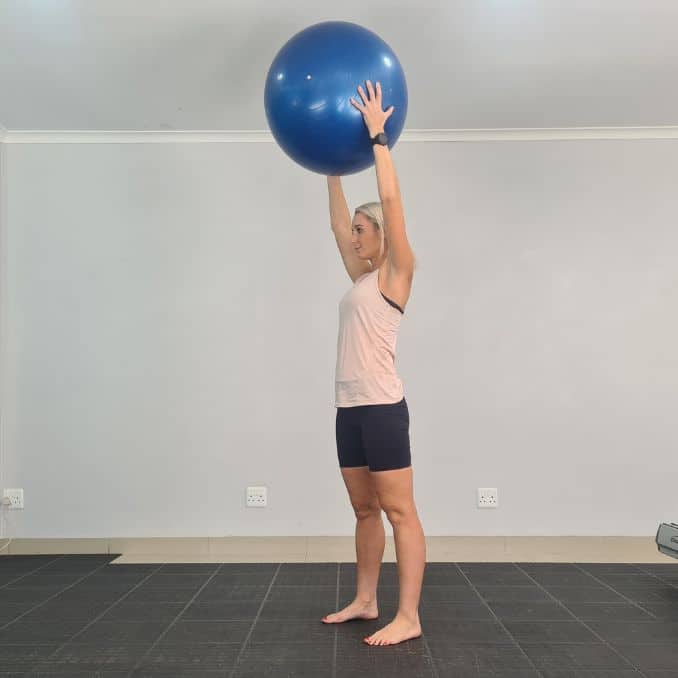 |
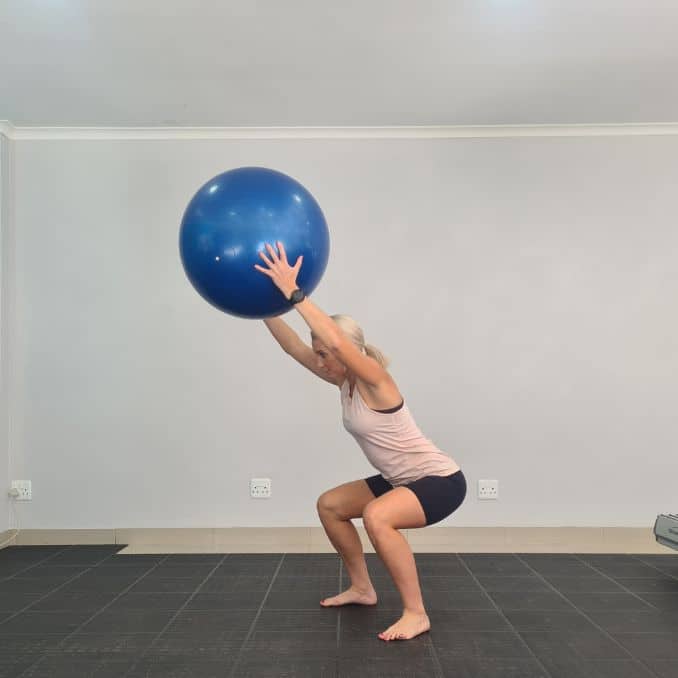 |
Overhead Squat
Benefits of Overhead Squat with Stability Ball
A. Core Strength
The stability ball challenges your core muscles, stabilizing your spine during the movement. This helps to improve your strength and core stability.
B. Shoulder Mobility
The overhead squat with a stability ball requires a lot of shoulder mobility, which is important for maintaining proper posture and preventing injury. This workout helps increase the range of motion in your shoulders, improving overall mobility and flexibility.
C. Leg Strength
The squatting motion targets your leg muscles, including your quadriceps, hamstrings, and glutes. By performing the overhead squat with a stability ball, you add an extra challenge to your legs, which helps to improve your leg strength.
2. Chest Stretch
For this exercise, you will need a large-size stability ball.
Lie on your back on the stability ball with your knees bent and feet flat on the floor. Maintain good alignment with your head, shoulders, hips, and knees. Engage your core and slowly bring your arms out to the sides, open your chest, and keep your arms straight. Hold this position for several deep belly breaths, in through your nose and out through your mouth. Relax and return to an upright standing position.
To intensify the exercise, you can slowly walk your feet through rolling the ball back and forth.
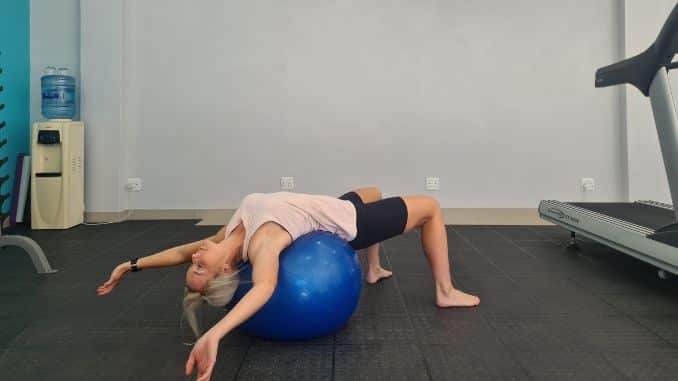 |
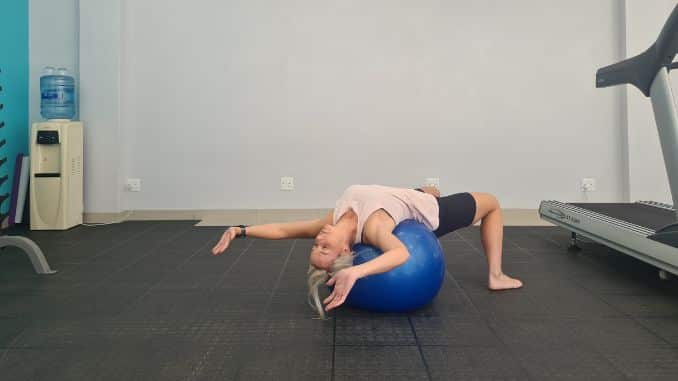 |
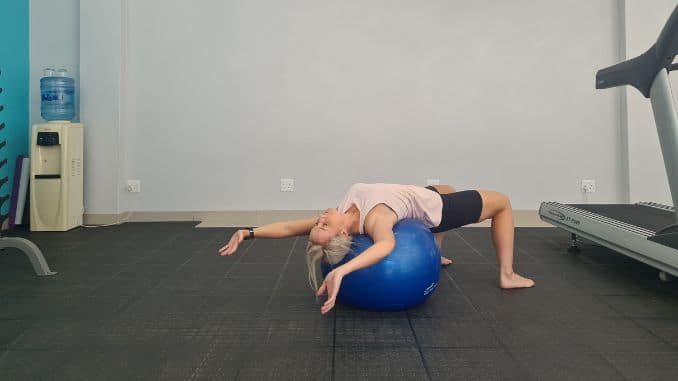 |
Chest Stretch
Benefits of Chest Stretch on the Stability Ball
A. Increases Chest Flexibility
The chest stretch on the stability ball helps to stretch and lengthen your sheet muscles. This can help to improve your posture by reducing the tightness and tension in your chest muscles.
B. Improves Shoulder Mobility
This exercise also targets your shoulder blades and joints, helping to increase your range of motion and flexibility. Improved shoulder mobility can lead to better posture and reduced risk of injury.
C. Enhances Spinal Mobility
As you stretch your chest on the stability ball, your spine is elongated, allowing for better spinal mobility. This can help reduce back pain and improve posture.
3. Stir the Pot
For this exercise, you will need a large-size stability ball.
Begin in a forearm plank position on a stability ball, and hands pressed together in front and keeping your legs in a straight line. Maintaining good alignment with your head, shoulder, hips, and legs. Contract your abdominal muscles and slowly move the stability ball using your elbows in a circular motion, like stirring a pot. Repeat the movement alternately on the opposite side. Complete 8-10 repetitions.
You can bring your knees down into a kneeling position to make the exercise easier.
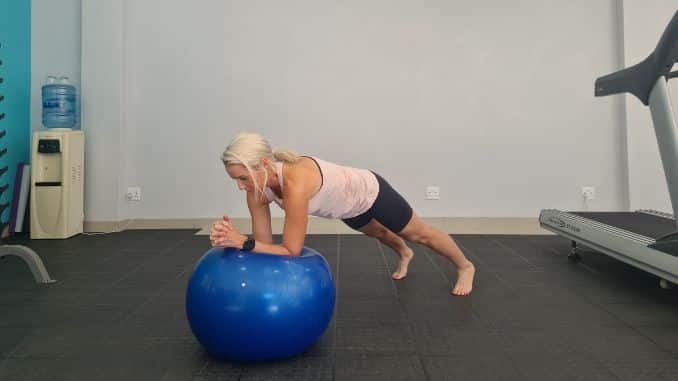 |
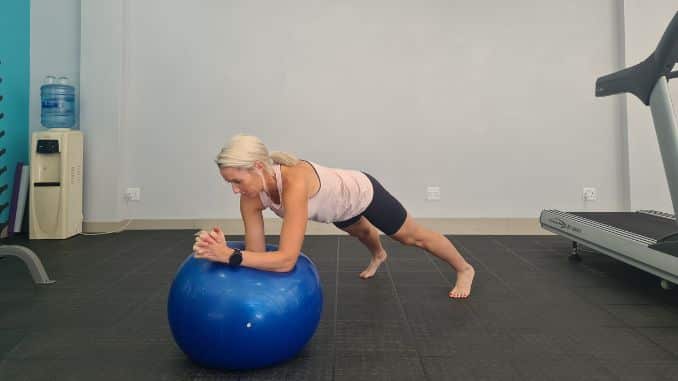 |
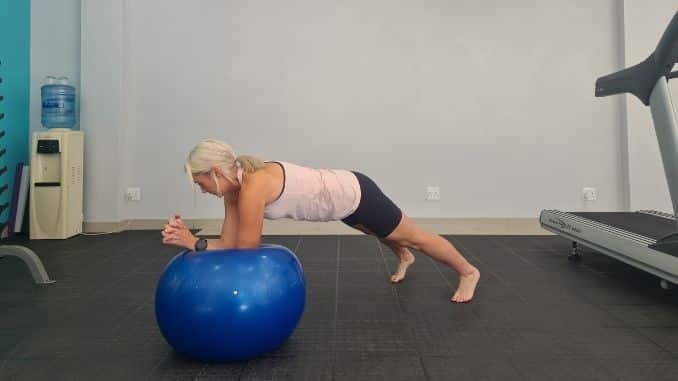 |
Stir the Pot
Benefits of Stir the Pot on the Stability Ball
A. Increase Core Activation
Performing the forearm plank on stability requires significant core stabilization to maintain balance by keeping your legs extended straight, which can help strengthen the muscles that support the spine and improve posture.
B. Improved Balance and Coordination
Balancing stability requires coordination and balance, which can help improve overall balance and stability.
C. Engaged multiple muscle groups:
The forearm plank on the stability ball not only targets the core muscles, and by doing a somewhat push-up position on the ball, it engages the glutes, hamstrings, shoulders, and upper back muscles.
4. Back Stretch
For this exercise, you will need a large-size stability ball.
Lie on your stomach on top of the stability ball with your elbows pressed on the floor. Lower your head, relax your upper body, and keep your legs straight. Hold the position for several deep belly breaths, in through your nose and out through your mouth. Relax and return to an upright position.
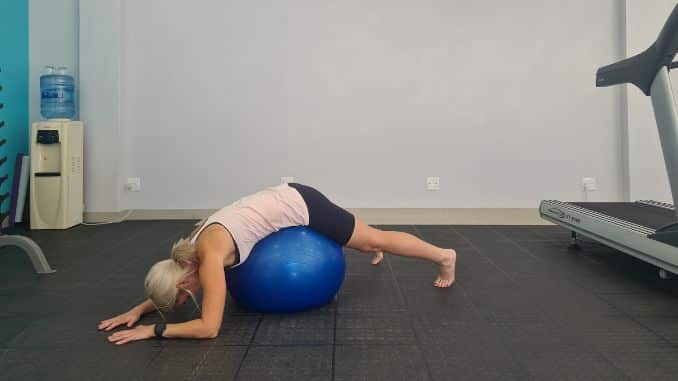
Back Stretch
Alternative Exercise
Lie on your stomach on top of the stability ball with your knees bent and hands pressed on the floor. Hold the position for several deep belly breaths through your nose and out through your mouth. Relax and return to an upright position.
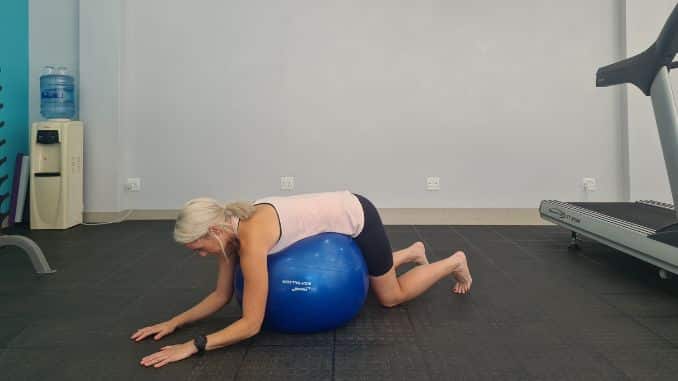 |
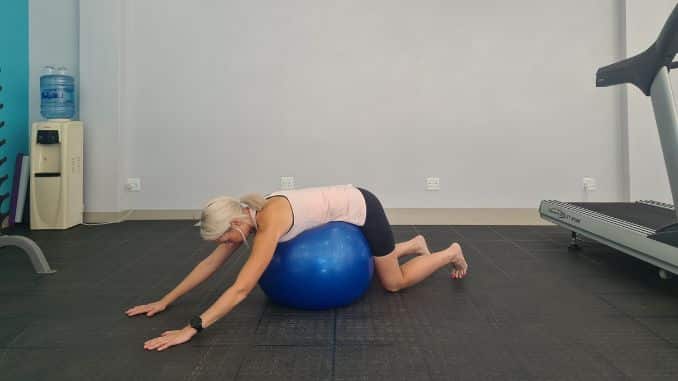 |
Alternative Exercise
Benefits of Back Stretching on the Stability Ball
1. Improved Spinal Mobility
Back stretches on the stability ball can help improve spinal mobility, reducing stiffness and pain in the back and neck.
2. Increase Flexibility
Stretching on the stability ball can help increase flexibility in the back, shoulders, and chest, improving posture and range of motion.
3. Strengthen core muscles
Balancing on the stability ball requires core stabilization, which can help strengthen the muscles that support the spine and improve posture.
Conclusion
The body needs exercise. It will become stronger and more resilient if you work on it. To keep your body strong and healthy, you must regularly exercise. One way to do this is to move around at work or on breaks. Another way is to take up a new hobby that involves moving around, like dancing or hiking. All of these activities can help keep your body healthy and strong. You must ensure that you rest your body enough to recover between bouts of exercise. One of the best ways to keep your body in check is by eating right and getting plenty of sleep. You'll be able to maintain a healthy weight and feel good all day if you do this.
The stability ball is a simple yet effective tool to work your core muscles and improve your posture. Ball exercises can also help you maintain strength while seated at your desk.
You don’t have to spend hours every day doing a workout to stay in shape. You can exercise on a stability ball, walk outside, swim, or even gently stretch. Just make sure you do at least one exercise for the core, the legs, and the back. Not only will you stay active throughout your mini-break, but you’ll also be gaining an array of positive rewards that come with physical activity.

